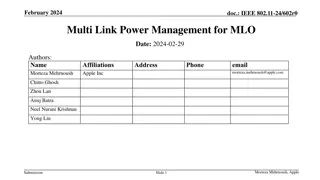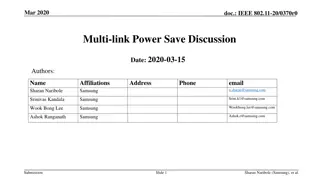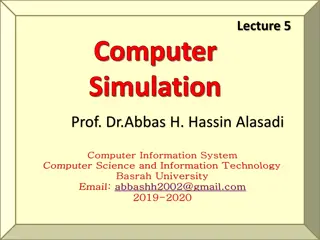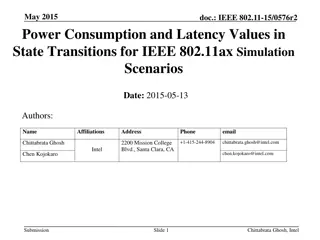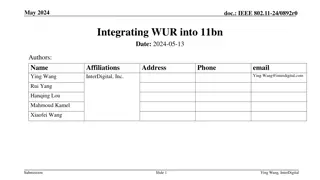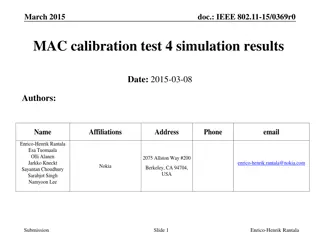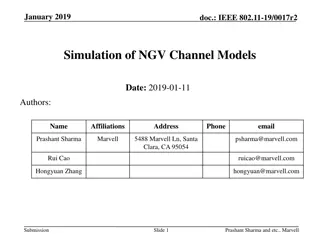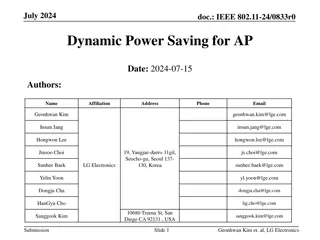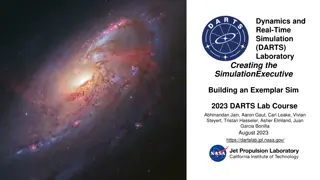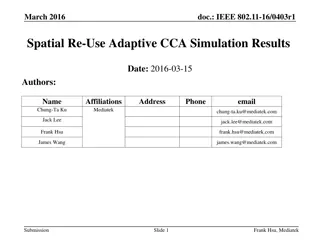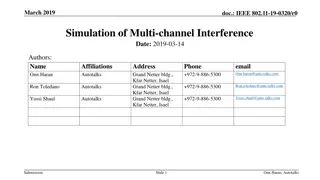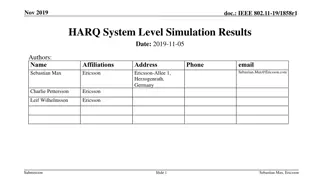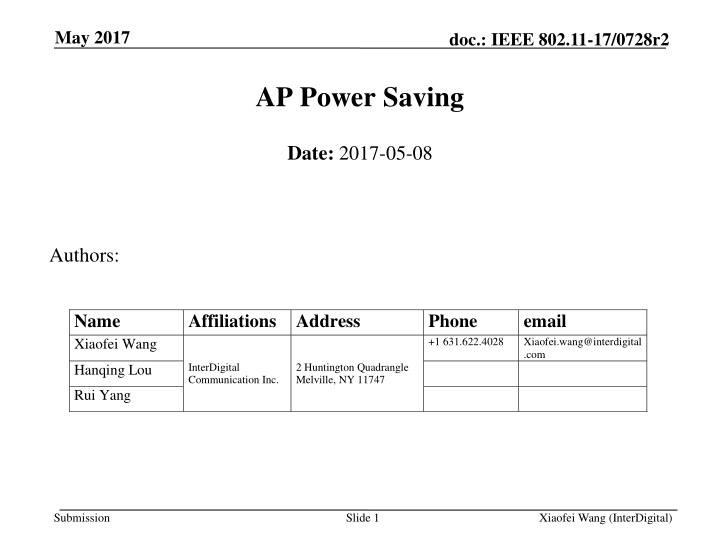
Simulation Results of AP Power Saving in IEEE 802.11-17
In this contribution, simulation results of AP power saving in IEEE 802.11-17 are discussed, focusing on scenarios involving mobile APs operating on batteries. Different power saving scenarios and their impact on network lifetime and user experience are analyzed. The benefits of AP power saving, including regulatory compliance, reduced interference, and enhanced security, are highlighted.
Download Presentation

Please find below an Image/Link to download the presentation.
The content on the website is provided AS IS for your information and personal use only. It may not be sold, licensed, or shared on other websites without obtaining consent from the author. If you encounter any issues during the download, it is possible that the publisher has removed the file from their server.
You are allowed to download the files provided on this website for personal or commercial use, subject to the condition that they are used lawfully. All files are the property of their respective owners.
The content on the website is provided AS IS for your information and personal use only. It may not be sold, licensed, or shared on other websites without obtaining consent from the author.
E N D
Presentation Transcript
May 2017 doc.: IEEE 802.11-17/0728r2 AP Power Saving Date: 2017-05-08 Authors: Name Xiaofei Wang Affiliations Address InterDigital Communication Inc. Phone +1 631.622.4028 email Xiaofei.wang@interdigital .com 2 Huntington Quadrangle Melville, NY 11747 Hanqing Lou Rui Yang Submission Slide 1 Xiaofei Wang (InterDigital)
May 2017 doc.: IEEE 802.11-17/0728r2 Abstract In this contribution, we provide simulation results of AP power saving and discuss the benefits of AP power saving. Submission Slide 2 Xiaofei Wang (InterDigital)
May 2017 doc.: IEEE 802.11-17/0728r2 Introduction Multiple usage scenarios have been proposed that involve mobile AP [1] UM 3: Cattle farm UM 5 & 6: Wearable devices Power consumption is a very important issue for mobile APs Mobile APs could be cell phones or ad hoc deployed devices operating on batteries without power plugs Power saving prolongs network lifetime; improves user experience Other benefits: regulatory, interference, security, etc. In this contribution, we provide simulation results on power savings for AP based on a number of scenarios AP power saving with varying duty cycles for AP s PCR Submission Slide 3 Xiaofei Wang (InterDigital)
May 2017 doc.: IEEE 802.11-17/0728r2 AP Power Saving Scenarios (1) Scenario 1: AP s PCR is always on, i.e., duty cycle 1 PCR beacons: BI: 100 ms Size: 100 bytes TX MCS: 1 Mbps/6.5 Mbps WUR beacons: BI: 10s TX duration: 144 us [2] UL data only; STA behavior: transmit data to AP directly when data arrives; No need for UL WUR packet from STA to AP AP power consumption is simulated APs PCR is always on Beacon Beacon Beacon Beacon Beacon Beacon Beacon WUR WUR WUR ACK ACK AP Data STA1 Data STA2 WUR TX PCR TX Submission Slide 4 Xiaofei Wang (InterDigital)
May 2017 doc.: IEEE 802.11-17/0728r2 AP Power Saving Scenarios (2) Scenario 2: AP s PCR is on duty cycle 1/2 PCR beacons: BI: 100 ms Size: 100 bytes TX MCS: 1 Mbps/6.5 Mbps WUR beacons: BI: 10s TX duration: 144 us [2] AP s PCR duty cycle: of ; UL data only; STA behavior: STA transmits PCR packet directly when AP is awake. Otherwise STA sends WUP to AP followed by PCR packet exch. AP s WUR is always on except when PCR is on AP power consumption is simulated APs PCR on APs PCR off APs PCR on APs PCR off APs PCR on APs PCR off APs PCR on Beacon Beacon Beacon Beacon Beacon WUR WUR ACK ACK AP Data STA1 UL WUP Data STA2 WUR TX PCR TX Submission Slide 5 Xiaofei Wang (InterDigital)
May 2017 doc.: IEEE 802.11-17/0728r2 AP Power Saving Scenarios (3) Scenario 3: AP s PCR is on duty cycle 1/4 PCR beacons: BI: 100 ms Size: 100 bytes TX MCS: 1 Mbps/6.5 Mbps WUR beacons: BI: 10s TX duration: 144 us [2] AP s PCR duty cycle: of 1/4; UL data only; STA behavior: STA transmits PCR packet directly when AP is awake. Otherwise STA sends WUP to AP followed by PCR packet exch. AP s WUR is always on except when PCR is on AP power consumption is simulated APs PCR on APs PCR off APs PCR on APs PCR off APs PCR on APs PCR off APs PCR on Beacon Beacon Beacon Beacon Beacon WUR WUR ACK ACK AP Data STA1 UL WUP Data STA2 WUR TX PCR TX Submission Slide 6 Xiaofei Wang (InterDigital)
May 2017 doc.: IEEE 802.11-17/0728r2 AP Power Saving Scenarios (4) Scenario 4: AP s PCR is always off except when being woken up or sending beacons, i.e., duty cycle 0 PCR beacons: BI: 100 ms Size: 100 bytes TX MCS: 1 Mbps/6.5 Mbps WUR beacons: BI: 10s TX duration: 144 us [2] AP s PCR is off except when: 1)Transmitting beacon; 2)When woken up by a STA; AP s WUR is always on except when PCR is on STA behavior: When having data, always send a WUP to wake up AP before continuing on with PCR packet exchanges APs WUR on APs PCR off APs PCR off APs PCR on APs PCR off APs PCR off APs PCR on Beacon Beacon Beacon Beacon Beacon WUR WUR ACK ACK AP UL WUP Data STA1 UL WUP Data STA2 Submission Slide 7 Xiaofei Wang (InterDigital) WUR TX PCR TX
May 2017 doc.: IEEE 802.11-17/0728r2 Simulation Assumptions (1/2) Matlab Simulations Simulation time: 100s Usage Model 3: Cattle farm: 1 farmer (Mobile AP) 30/50 cows (STAs) Traffic Assumptions: UL data only Packet arrival interval per STA: [5:5:50] s Packet size: 32 bytes AP PCR Duty cycle: [1, , 1/4, 0] AP Power Consumptions simulated Submission Slide 8 Xiaofei Wang (InterDigital)
May 2017 doc.: IEEE 802.11-17/0728r2 Simulation Assumptions (2/2) Submission Slide 9 Xiaofei Wang (InterDigital)
May 2017 doc.: IEEE 802.11-17/0728r2 Simulation Results (1/4) Packet arrival interval (s) 5 10 15 20 25 30 35 40 45 50 Duty cycle 1 0.057 0.057 0.057 0.057 0.057 0.057 0.057 0.057 0.057 0.057 Duty cycle 1/2 0.03 0.03 0.03 0.03 0.03 0.03 0.03 0.03 0.03 0.03 Duty cycle 1/4 0.017 0.017 0.017 0.017 0.017 0.017 0.017 0.017 0.017 0.017 Duty cycle 0 0.003 0.003 0.003 0.003 0.003 0.003 0.003 0.003 0.003 0.003 Submission Slide 10 Xiaofei Wang (InterDigital)
May 2017 doc.: IEEE 802.11-17/0728r2 Simulation Results (2/4) Packet arrival interval (s) 5 10 15 20 25 30 35 40 45 50 Duty cycle 1 0.0554 0.0554 0.0554 0.0554 0.0554 0.0554 0.0554 0.0554 0.0554 0.0554 Duty cycle 1/2 0.0281 0.028 0.028 0.028 0.028 0.028 0.028 0.028 0.028 0.028 Duty cycle 1/4 0.0144 0.0143 0.0143 0.0143 0.0143 0.0143 0.0143 0.0143 0.0143 0.0143 Duty cycle 0 0.0007 0.0006 0.0006 0.0006 0.0006 0.0006 0.0006 0.0006 0.0006 0.0006 Submission Slide 11 Xiaofei Wang (InterDigital)
May 2017 doc.: IEEE 802.11-17/0728r2 Simulation Results (3/4) Packet arrival interval (s) 5 10 15 20 25 30 35 40 45 50 Duty cycle 1 0.0575 0.0574 0.0574 0.0574 0.0574 0.0574 0.0574 0.0574 0.0574 0.0574 Duty cycle 1/2 0.0303 0.0302 0.0302 0.0302 0.0302 0.0302 0.0302 0.0302 0.0302 0.0302 Duty cycle 1/4 0.0167 0.0166 0.0166 0.0166 0.0166 0.0166 0.0166 0.0166 0.0166 0.0166 Duty cycle 0 0.0032 0.003 0.003 0.003 0.003 0.003 0.0029 0.0029 0.0029 0.0029 Submission Slide 12 Xiaofei Wang (InterDigital)
May 2017 doc.: IEEE 802.11-17/0728r2 Simulation Results (4/4) Packet arrival interval (s) 5 10 15 20 25 30 35 40 45 50 Duty cycle 1 0.0555 0.0554 0.0554 0.0554 0.0554 0.0554 0.0554 0.0554 0.0554 0.0554 Duty cycle 1/2 0.0281 0.028 0.028 0.028 0.028 0.028 0.028 0.028 0.028 0.028 Duty cycle 1/4 0.0144 0.0143 0.0143 0.0143 0.0143 0.0143 0.0143 0.0143 0.0143 0.0143 Duty cycle 0 0.0008 0.0007 0.0006 0.0006 0.0006 0.0006 0.0006 0.0006 0.0006 0.0006 Submission Slide 13 Xiaofei Wang (InterDigital)
May 2017 doc.: IEEE 802.11-17/0728r2 Observations Impact by AP s PCR Duty Cycle In all scenarios with DC < 1, significant power saving is achieved When AP s PCR s DC = , AP s power consumption is slightly higher than 50%of that when AP s PCR s DC = 1 When AP s PCR s DC = 1/4, AP s power consumption is slightly higher than 25%of that when AP s PCR s DC = 1 When AP s PCR s DC = 0, AP s power consumption is around 1.2% - 5.2% (depending on PCR beacon rate) of that when AP s PCR s DC = 1 Impact by Packet Arrival Rate Small impact when packet arrival interval increase 5 -> 50s except when DC = 0 Impact by Number of STAs No significant impact when the number of STAs is increased from 30 to 50 Impact by PCR Beacon Tx Rate Only significant when AP PCR DC = 0 Slide 14 Submission Xiaofei Wang (InterDigital)
May 2017 doc.: IEEE 802.11-17/0728r2 When is AP Power Saving Desirable When aggregated traffic in the entire network is low It is suitable for some number of IoT usage models and scenarios However, power saving and network lifetime may be critical in these scenarios Wake up AP procedure may enable low latency while maintaining low power consumptions Latency can also be critical for some of the IoT scenarios where power saving is critical as well When a STA can send a Wake up Packet Likely possible if a STA can use its OFDM transmitter to transmit WUP It may not be appropriate if: A large number of active STAs present in the BSS Traffic load is heavy in the BSS Slide 15 Submission Xiaofei Wang (InterDigital)
May 2017 doc.: IEEE 802.11-17/0728r2 Technical changes needed for AP Power Save An AP power saving mode: Only when scenario is appropriate E.g., AP delivered together with a cattle monitoring sensor network Only when all STAs associated with it support AP power saving Indicated by capability An AP power saving mode with these restrictions should not violate the PAR Cost, e.g.: A low-cost WUR receiver at AP (An mobile AP may already have a WUR if it also acts as a WUR STA) Procedure for going into power saving for APs of which all associated STAs have indicated of capable of handling AP Power Saving Wake up procedure for AP AP Discovery process Slide 16 Submission Xiaofei Wang (InterDigital)
May 2017 doc.: IEEE 802.11-17/0728r2 Conclusions An AP Power Save feature may enable critical functionalities for some IoT scenarios Allow long period of low power operation of its BSS while maintaining low latency for APs that are operated on battery power Simulation shows that AP power save provides significant energy saving benefits even with PCR DC = . With DC = 0, AP s power consumption could be as low as 1.2% of that when DC = 0 802.11ba should consider to optionally put 11ba APs to power saving mode when a certain set of restrictions are met E.g., when all associated STAs support AP power saving capabilities Submission Slide 17 Xiaofei Wang (InterDigital)
May 2017 doc.: IEEE 802.11-17/0728r2 References [1] 11-17/0029r5, WUR Usage Model Document, Mar. 2017 [2] 11-17/0343r3, WUR Beacon, Mar. 2017 [3] 11-17/0124r1, WUR MAC and Wakeup Frame, Jan. 2017 [4] 11-16/1400r0, Power Efficient WUR AP Discovery, Nov. 2016 Submission Slide 18 Xiaofei Wang (InterDigital)
May 2017 doc.: IEEE 802.11-17/0728r2 Straw Poll Do you agree to add to the 802.11ba SFD AP may go into WUR power saving mode by turning off its PCR and monitoring for WUR packets using its WUR when certain criteria are met, e.g., when all STAs are associated with it support AP WUR power saving. Submission Slide 19 Xiaofei Wang (InterDigital)


